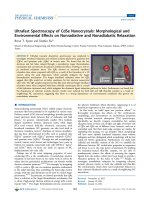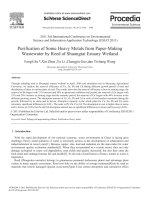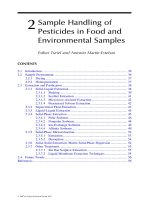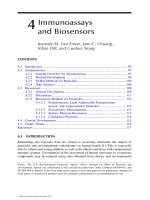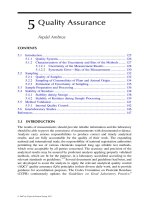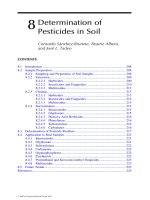Surface modification of ferromagnetic nanoparticles for separation of toxic heavy metals and environmental applications
Bạn đang xem bản rút gọn của tài liệu. Xem và tải ngay bản đầy đủ của tài liệu tại đây (2.51 MB, 226 trang )
SURFACE MODIFICATION OF
FERROMAGNETIC NANOPARTICLES FOR
SEPARATION OF TOXIC HEAVY METALS AND
ENVIRONMENTAL APPLICATIONS
ZAYED BIN ZAKIR SHAWON
NATIONAL UNIVERSITY OF SINGAPORE
2013
SURFACE MODIFICATION OF
FERROMAGNETIC NANOPARTICLES FOR
SEPARATION OF TOXIC HEAVY METALS AND
ENVIRONMENTAL APPLICATIONS
ZAYED BIN ZAKIR SHAWON
B.Sc. (Chemical Engineering)
Bangladesh University of Engineering & Technology
A THESIS SUBMITTED
FOR THE DEGREE OF DOCTOR OF PHILOSOPHY
DEPARTMENT OF CHEMICAL & BIOMOLECULAR
ENGINEERING
NATIONAL UNIVERSITY OF SINGAPORE
2013
Acknowledgements
First and foremost, I would like to offer my sincerest gratitude to my
supervisors, Associate Professor Dr. Kus Hidajat and Associate Professorial
Fellow Dr. Mohammad Shahab Uddin, who have supported me throughout my
PhD candidature with their patience and knowledge whilst allowing me the
room to work in my own way. Without their kind support, this thesis, would
not have been completed or written. I had been blessed with a friendly and
enthusiastic group of fellow mates. I would like to take this opportunity to
express my heartfelt gratitude and sincere admiration to my lab colleagues Dr.
Abu Zayed Md. Badruddoza and Dr. Sudipa Ghosh. I would also sincerely
express my love and gratefulness to my wonderful FYP students Soh Wei Min
Louis, Li Yiwang, Tan Kia Aun Isaac (B-Tech), Kow Wei Hao, Tay Wei Jin
Daniel and Low Baoxia Michelle. I would also like to thank all staff members
in the Department of Chemical and Biomolecular Engineering and my lab
officers Jamie Siew and Sylvia Wan who have helped me throughout my entire
work. I would like to render much tribute to my beloved parents, siblings for
their boundless love and support, my beloved wife for her understanding,
moral support and inspiration and friends for encouraging me during my entire
research work. Finally, I would like to thank the National University of
Singapore for providing me the ‘Research Scholarship’ and to the department
of Chemical and Biomolecular Engineering for providing all the facilities.
Zayed Bin Zakir Shawon
August, 2013
Declaration
I hereby declare that this thesis is my original work and it has been written by
me in its entirety. I have duly acknowledged all the sources of information
which have been used in the thesis.
This thesis has also not been submitted for any degree in any university
previously.
Zayed Bin Zakir Shawon
21
st
August 2013
i
Table of Contents
Summary vi
Nomenclature ix
List of Tables xi
List of Figures xiii
Chapter 1. Introduction 1
1.1 General background 1
1.2 Objectives of this project 3
1.3 Organization of the thesis 5
References 6
Chapter 2. Literature review 8
2.1 Magnetism 8
2.2 Mechanism of magnetic separation 13
2.3 Ferrofluids and its preparation 14
2.4 Magnetic nanoparticles 16
2.4.1 Properties of magnetic particles 17
2.4.2 Surface modification of magnetic nanoparticles 18
2.4.3 Application of magnetic nanoparticles 19
2.5 Heavy metals and its pollution 19
2.5.1 Sources of heavy metal pollution and its effects 22
2.6 Cyclodextrin and its classification 29
2.7 Ionic liquids (Ils) and its application 32
2.8 Acid blue (Dye) 36
2.9 Janus particles 38
2.9.1 Application of janus particles 41
ii
2.10 Adsorption and desorption 42
2.10.1 Adsorption equilibrium 43
2.11 Scope of the thesis 44
References 47
Chapter 3. Materials and methods 64
3.1 Materials 64
3.2 Methods 65
3.2.1 Synthesis of bare magnetic nanoparticles (bare Fe
3
O
4
) 65
3.2.2 Synthesis of phosphonium based silane (PPhSi) 66
3.2.3 Synthesis of phosphonium based silane coated magnetic nanoparticles
(PPhSi-MNPs) 67
3.2.4 Synthesis of carboxymethyl-β-cyclodextrin (CMCD) 67
3.2.5 Synthesis of carboxymethyl-β-cyclodextrin polymer (CDpoly) 68
3.2.6 Surface modification of magnetic nanoparticles with CM-β-CD (CMCD-
MNPs) 69
3.2.7 Surface modification of magnetic nanoparticles with CM-β-CD polymer
(CDpoly-MNPs) 70
3.2.8 Synthesis of janus magnetic nanoparticles (JMNPs) 71
3.3 Batch experiments 73
3.3.1 Adsorption and desorption of As(V) and Cr(VI) ions onto PPhSi-MNPs 73
3.3.2 Adsorption and desorption of heavy metal ions onto CDpoly-MNPs 74
3.3.3 Adsorption of acid blue 25 and Pb
2+
onto CMCD-MNPs 76
3.3.4 Adsorption of Hg
2+
onto bare, janus and fully amin coated magnetic
nanoparticles 77
3.4 Analytical methods 78
iii
3.4.1 Fourier-transform infrared spectroscopy (FTIR) 78
3.4.2 Transmission electron microscopy (TEM) 79
3.4.3 X-ray diffraction (XRD) analysis 79
3.4.4 Vibrating sample magnetometer (VSM) 80
3.4.5 Zeta potential analysis 80
3.4.6 Thermogravimetric analysis (TGA) 81
3.4.7 X-ray photoelectron spectroscopy (XPS) 81
3.4.8 Inductively coupled plasma mass spectrometry (ICP-MS) 82
Chapter 4. Ionically modified magnetic nanoparticles for arsenic and chromium
removal 83
4.1 Introduction 83
4.2 Results and discussion 87
4.2.1 Synthesis and characterization of magnetic nanoparticles 87
4.3 Adsorption of As(V) and Cr(VI) ions 92
4.3.1 Effects of pH 92
4.3.2 Effects of contact time and adsorption kinetics 94
4.3.3 Equilibrium studies of As(V) and Cr(VI) 97
4.3.4 Adsorption mechanism 101
4.3.5 Effect of coexisting ions 103
4.3.6 Desorption 104
4.4 Conclusion 106
References 108
Chapter 5. Selective heavy metals removal by Fe
3
O
4
/cyclodextrin polymer
nanocomposites 115
5.1 Introduction 115
iv
5.2 Results and discussion 118
5.2.1 Synthesis and characterization of magnetic nanoparticles 118
5.3 Adsorption of Pb
2+
, Cd
2+
and Ni
2+
ions 122
5.3.1 Effects of pH 122
5.3.2 Effects of ionic strength 124
5.3.3 Effects of temperature 124
5.3.4 Equilibrium studies in single-component system 125
5.3.5 Effects of contact time and adsorption kinetics 130
5.3.6 Multi-component adsorption 133
5.3.7 Adsorption mechanism 137
5.3.8 Desorption and reusability 140
5.4 Conclusion 142
References 144
Chapter 6. Simultaneous removal of acid blue-25 and Pb
2+
from aqueous solutions
using carboxymethyl-β-cyclodextrin functionalized magnetic nanoparticles 153
6.1 Introduction 153
6.2 Results and discussion 156
6.2.1 Synthesis and characterizations of nano-sized magnetic particles 156
6.3 Adsorption of AB 25 and Pb
2+
163
6.3.1 Effect of pH 163
6.3.2 Effects of contact time and adsorption kinetics 166
6.3.3 Equilibrium studies of AB 25 and Pb
2+
170
6.4 Conclusion 176
References 177
v
Chapter 7. Synthesis and characterization of janus magnetic nanoparticles and its
application as an adsorbent 180
7.1 Introduction 180
7.2 Particle characterization 181
7.2.1 Scanning electron microscopy (SEM) and energy dispersive X-ray analysis
(EDX) 181
7.2.2 Fourier transform infrared spectroscopy (FTIR) 183
7.2.3 Thermogravimetric analysis (TGA) 184
7.2.4 Transmission electron microscopy (TEM) 185
7.3 Results and discussion 185
7.3.1 Adsorption of Hg
2+
185
7.4 Conclusion 188
References 189
Chapter 8. Conclusion and recommendations 191
8.1 Conclusion 191
8.2 Recommendations for future work 195
8.2.1 Surface functionalization with ionic liquids 195
8.2.2 Using functionalized nanoparticles in hybrid membranes 196
8.2.3 Improvement in the adsorption desorption capacity 197
8.2.4 Exploring janus particles in biomedical application 197
8.2.5 Exploring Langmuir-Blodgett technique for janus nanoparticles synthesis
198
8.2.6 Packed bed and fluidized bed separation with nanoadsorbents 200
References 202
List of Publications 204
vi
Summary
Many industries like paint, leather, battery industries etc. discharge toxic
heavy metals in the environment. These heavy metals are life-threatening for
both human health and water bodies. Different methods like, filtration, ion
exchange, membrane separation, adsorption etc. have been developed to
remove the toxic heavy metal ions from the wastewater. Among those
methods, adsorption has become popular because of its simplicity of
operation. Recently, scientists are utilizing ferromagnetic nanoparticles to
remove toxic heavy metals from wastewater. Ferromagnetic nanoparticles are
superparamagnetic and offer very fascinating physical and chemical
properties. The adsorption capability of these nanoadsorbents enhances when
they are functionalized with other materials. In this research program,
nanoparticles were functionalized with ionic liquid, beta cyclodextrin and its
polymer, 3-aminopropyl(triethoxy)silane etc. and were exploited to remove
heavy metals i.e., lead, cadmium, nickel, arsenic, chromium, mercury etc. The
synthesized particles had been characterized by various instrumental methods,
such as TEM, EDX, FTIR, SEM, VSM, TGA etc. The adsorption data have
been analyzed through the adsorption isotherms and kinetic studies.
A new type of ionic liquid ‘Phosphonium silane’ was synthesized in the
laboratory and was successfully grafted on the surface of the magnetic
nanoparticles. These particles were exploited to adsorb arsenic and chromium
in their anionic form i.e., arsenate and chromate, since the coating has strong
positively charged adsorption site. The reaction mechanism was studied and
vii
predicted that the adsorption occurred via ion exchange mechanism.
Moreover, these newly invented functionalized magnetic nanoparticles are
capable enough to adsorb its target in presence of other co-existing
competitive anions or radicals.
Selective adsorption of lead was studied with the carboxymethyl-β-
cyclodextrin functionalized magnetic nanoparticles. Adsorption studies were
carried out in single, binary and ternary mixtures. The other competitor
pollutant heavy metal ions were cadmium and nickel. Adsorption of lead was
found higher in all the three cases. Moreover, simulated wastewater sample
was prepared in the laboratory by spiking different heavy metal ions in
different compositions along with lead. Carboxymethyl-β-cyclodextrin
functionalized magnetic nanoparticles showed fascinating capability of
adsorbing lead to a higher extent in the simulated raw water sample also.
Carboxymethyl-β-cyclodextrin polymer functionalized magnetic nanoparticles
were exploited to adsorb organic and inorganic pollutant i.e., Acid blue 25 dye
and lead simultaneously. In this case, the adsorption studies were carried out
in single and binary mixtures. Acid blue 25 itself provided adsorption sites and
thus enhanced the uptake of lead onto the surface of the magnetic
nanoparticles. Lead also played a role as a coagulating agent for the dye and
enhanced the adsorption of the dye more than three times, than the adsorption
of dye onto the surface of the adsorbent in single component system. It was
observed that, carboxymethyl-β-cyclodextrin polymer functionalized magnetic
viii
nanoparticles were capable to remove both organic and inorganic pollutants
simultaneously.
Attempts were also taken to prepare partially functionalized magnetic
nanoparticles or janus particles. These particles were synthesized by coating 3-
aminopropyl(triethoxy)silane partially onto the particle surface of magnetic
nanoparticles via Pickering emulsion method. Both instrumental methods of
characterization and adsorption of mercury proved that, the particles
synthesized by this method were partially functionalized.
ix
Nomenclature
Symbols Description
B Magnetic flux density
C
e
Equilibrium concentration
H Magnetic field intensity
K
L
Langmuir constant
K
F
Freundlich constant
M Induced magnetic moment
n Arbitrary power constant
q
e
Adsorption at equilibrium
q
m
Maximum adsorption capacity
T
c
Curie temperature
T
N
Neel temperature
V Volume
W Mass
μ Magnetic permeability
Magnetic susceptibility
Abbreviation
AB Acid blue 25 (Dye)
APTES 3-aminopropyl triethoxy silane
BET Brunauer- Emmett-Teller method
CF Coercive force
CMCD Carboxymethyl-β-cyclodextrin
EDTA Ethylenediaminetetraacetic acid
x
FF Ferrofluids
FTIR Fourier transforms infrared spectroscopy
IL Ionic liquids
ICP-MS Inductively couple plasma mass spectrometry
MNP Magnetic nanoparticles
MRF Magnetorheological fluids
PAA Polyacrylic acid
PDMAEMA Polydimethylamino ethylmethacrylate
PPhSi Phosphonium silane
PSSNa Polystyrene sodium sulfonate
RM Remnant magnetization
TEM Transmission electron microscopy
TGA Thermogravimetric analysis
VSM Vibrating sample magnetometer
XPS X-ray photoelectron spectroscopy
xi
List of Tables
Table 2- 1 A list of works on heavy metal removal from waste water by
various adsorbents 23
Table 2- 2 Few notable works on ionic liquids as adsorbent for heavy metals
35
Table 2- 3 List of works on removal of dye and heavy metals 37
Table 4- 1 Kinetic parameters for the adsorption of As(V) and Cr(VI) ions
onto PPhSi-MNPs. 97
Table 4- 2 Adsorption isotherm parameters for As(V) and Cr(VI) onto bare
MNPs and PPhSi-MNPs at pH 3, 25
o
C. 99
Table 4- 3 Comparison of maximum adsorption capacities of PPhSi-MNPs
with those of some other adsorbents reported in literature for As(V) and
Cr(VI) adsorption. 100
Table 4- 4 Desorption efficiencies of As(V) and Cr(VI) using different buffer
eluents. 106
Table 5- 1 Adsorption isotherm parameters for Pb
2+
, Cd
2+
and Ni
2+
ions onto
bare MNPs and CDpoly-MNPs at 25 ºC in single-component system. 126
Table 5- 2 Comparison of maximum adsorption capacity of CDpoly-MNPs
with those of some other adsorbents reported in literature for Pb
2+
, Cd
2+
and
Ni
2+
adsorption. 127
Table 5- 3 Adsorption kinetic parameters of Pb
2+
, Cd
2+
and Ni
2+
onto CDpoly-
MNPs at 25
o
C and pH 5.5. 133
xii
Table 5- 4 Quality of urban wastewater simulating a typical paint industry
effluent. 137
Table 6- 1 Adsorption kinetic parameters of AB 25 and Pb
2+
(pH 5) on the
surface of CMCD modified on magnetic nanoparticle adsorbent. 170
Table 6- 2 Adsorption isotherm parameters for AB 25 and Pb
2+
mixtures in
different combinations onto CMCD-MNPs at pH 5, 25
o
C. 173
Table 6- 3 Quality of urban wastewater simulating a typical textile industry
effluent. 176
Table 7- 1 Silicon weight percentage of janus and fully coated nanoparticles
183
Table 7- 2 Values of different adsorption parameters 187
xiii
List of Figures
Figure 2- 1 Hysteresis loop for magnetic materials 12
Figure 2- 2 Schematic diagram of the magnetic separation of non magnetic
targets 14
Figure 2- 3 Three types of cyclodextrin 30
Figure 2- 4 The formation of CD inclusion complex in aqueous media 31
Figure 2- 5 Chemical Structure of Acid blue 25 37
Figure 3-1 An illustration of coating CMCD on the surface of iron oxide
nanoparticles 70
Figure 3-2 Schematic presentation of CM-β-CD polymer grafting on Fe
3
O
4
nanoparticles 70
Figure 3-3 Reaction steps to prepare bare magnetite particles and to coat with
APTES fully or partially 72
Figure 4- 1 Synthesis steps of PPhSi and PPhSi-MNPs 88
Figure 4- 2 XRD pattern of PPhSi-MNPs 88
Figure 4- 3 Magnetization curve for (a) bare Fe
3
O
4
MNPs and (b) PPhSi-
MNPs. (The magnetic properties of these nanoparticles were measured by
vibrating sample magnetometer (VSM) at room temperature). Inset:
Separation of magnetic nanoparticles from liquid phase 89
Figure 4-4 (a) FTIR spectrum of phosphonium silane coated magnetic
nanoparticles (PPhSi-MNPs). (b) TEM image of PPhSi-MNPs 90
xiv
Figure 4- 5 Zeta potentials of bare Fe
3
O
4
MNPs and PPhSi-MNPs at different
pH (25
o
C) 92
Figure 4- 6 Effect of solution pH on the adsorption of As(V) and Cr(VI) onto
PPhSi-MNPs at 25
o
C 94
Figure 4- 7 (a) Effect of contact time on the adsorption of As(V) and Cr(VI)
by PPhSi-MNPs (pH 3, temperature: 25
o
C, concentration: 100 mg/L); (b)
Linear plot of pseudo-second-order kinetic model for the adsorption of As(V)
and Cr(VI) 96
Figure 4- 8 Adsorption isotherms for As(V) and Cr(VI) adsorbed onto bare
MNPs and PPhSi-MNPs at pH 3, 25
o
C 98
Figure 4- 9 (a) Full-range XPS spectra of PPhSi-MNPs and after As(V) and
Cr(VI) adsorption; (b) XPS As 3d spectrum of PPhSi-MNPs after As(V)
adsorption; and (c) XPS Cr 2p3/2 spectrum of PPhSi-MNPs after Cr(VI)
adsorption 102
Figure 4- 10 Proposed reaction mechanism of adsorption of As(V) and Cr(VI)
ions onto PPhSi-MNPs 103
Figure 4- 11 Effects of coexisting ions on the adsorption of As(V) and Cr(VI)
onto PPhSi-MNPs. 104
Figure 4- 12 Four consecutive adsorption–desorption cycles of PPhSi-MNPs
for As(V) and Cr(VI) (initial concentration of each metal: 200 mg/L, pH 3.0,
desorption agent: 0.1 mol/L NaOH for As(V) and 0.1 mol/L NaHCO
3
for
Cr(VI)). 105
Figure 5- 1 (A) FTIR spectra of (a) CM-β-CD polymer, (b) uncoated MNPs
and (b) CDpoly-MNPs, (B) XPS C 1s spectrum of CDpoly-MNPs, (C) TEM
xv
image of CDpoly-MNPs, and (D) zeta potentials of bare MNPs and CDpoly-
MNPs at different pH. 119
Figure 5- 2 Size distribution of CM-β-CD polymer coated magnetic
nanoparticles (CDpoly-MNPs). 120
Figure 5- 3 Magnetization curve for bare Fe
3
O
4
MNPs and CDpoly-MNPs.
(The magnetic properties of the bare and CM-β-CD polymer coated Fe
3
O
4
nanoparticles were measured by vibrating sample magnetometer (Model 1600,
DMS) at room temperature). 121
Figure 5- 4 (a)-(c) Effect of pH, ionic strength and temperature on the
adsorption of Pb
2+
, Cd
2+
and Ni
2+
ions onto CDpoly-MNPs, (d)-(f) the
adsorption isotherm of Pb
2+
, Cd
2+
and Ni
2+
ions in single-component system
onto uncoated MNPs and CDpoly-MNPs at pH 5.5 123
Figure 5- 5 (a) Effect of contact time on Pb
2+
, Cd
2+
and Ni
2+
adsorption by
CDpoly-MNPs. (b) Linear plot of pseudo-second-order kinetic model for Pb
2+
,
Cd
2+
and Ni
2+
ions. (Conditions: initial metal concentration; 300 mg/L, pH 5.5,
temperature; 25
o
C) 131
Figure 5- 6 (a) Percentage removal of Ni
2+
, Cd
2+
and Pb
2+
from single, binary
and ternary mixtures (Each metal concentration: 2 mmol/L, adsorbents: 120
mg, temperature: 25 °C, pH 5.5 and contact time: 2 h). (b) Plot of the
adsorption capacities versus the covalent index 135
Figure 5- 7 FTIR spectra of CDpoly-MNPs; (a) before adsorption, (b) Pb
2+
loaded, (c) Cd
2+
loaded, (d) Ni
2+
loaded. 139
Figure 5- 8 (a) Percentage recovery of Pb
2+
, Cd
2+
and Ni
2+
from CDpoly-
MNPs using different desorption eluents, (b) Four consecutive adsorption–
xvi
desorption cycles of CDpoly-MNPs adsorbent for Pb
2+
(initial concentration:
300 mg/L, pH 5.5, desorption agent: 10 mL of 0.01 mol/L HNO
3
) 142
Figure 6- 1 FTIR spectra of (a). Uncoated MNPs, (b). CMCD-MNPs, and (c).
CMCD. 157
Figure 6- 2 Zeta potential of uncoated MNPs and CMCD coated MNPs. 158
Figure 6- 3 XPS C 1s spectrum of CMCD-MNPs. 159
Figure 6- 4 TGA curve of (a) Uncoated MNPs and (b) CMCD coated MNPs
160
Figure 6- 5 TEM micrographs and size distribution of bare CMCD-MNPs 161
Figure 6- 6 Magnetization curve of bare MNPs and CMCD coated MNPs at
25
o
C 162
Figure 6- 7 Effect of pH on the adsorption of AB 25 and Pb
2+
onto CMCD-
MNPs (initial concentration AB 25 = 1000 mg/L and Pb
2+
= 200 mg/L,
Temperature 25
o
C) 163
Figure 6- 8 Zeta potential analyses of AB 25 and CMCD-MNPs. 164
Figure 6- 9 The amount of (a) AB 25 in presence of Pb and (b) Pb
2+
in
presence of AB 25 adsorbed onto CMCD-MNPs versus time at three different
concentrations (conditions: initial concentrations = Pb 200 mg/L and AB 25 =
100, 200, 500 mg/L adsorbent mass = ± 120 mg , their optimum pH, volume =
10 mL, agitation speed = 230 rpm, temperature 25
o
C). 168
Figure 6- 10 Pseudo-second-order kinetic plots of the adsorption of (a) AB 12
and (b) Pb
2+
onto CMCD-MNPs at three different temperatures (conditions:
initial concentration = 100, 200, 500 mg/L AB 25 and Pb
2+
200 mg/L,
xvii
adsorbent mass = ± 120 mg, pH 5, volume = 10 m mL, agitation speed = 200
rpm, temperature 25
o
C) 169
Figure 6- 11 Equilibrium isotherms for the adsorption of (a) AB 25 and (b)
Pb
2+
onto CMCD-MNPs (at pH 5 and 25
o
C) 172
Figure 7- 1 SEM image of wax balls after filtration. 182
Figure 7- 2 EDX along the cross-section of a cut wax balls. 182
Figure 7- 3 FTIR Spectra of Bare and janus Magnetic Nanoparticles 183
Figure 7- 4 TGA thermograms of bare, janus and fully coated magnetic
nanoparticles 184
Figure 7- 5 TEM micrograph of janus magnetic nanoparticles. (Scale bar is 20
nm) 185
Figure 7- 6 Adsorption isotherms for bare, janus and fully coated magnetic
nanoparticles 186
Figure 8- 1 Schematic diagram of a dual coated janus particle 198
Figure 8- 2 Schematic diagram of Langmuir-Blodgett method (Chen et al.
2007) 199
Figure 8- 3 Schematic diagram of a packed bed column (Shavandi et al. 2012)
201
Chapter 1
1
Chapter 1. Introduction
1.1 General background
Heavy metal pollution emerging from industrial effluents is now a major
concern. Heavy metals are non-biodegradable and slowly accumulate in the
living body organs or organisms and thereby show chronic effects eventually.
Heavy metals are those metals which have specific gravity more than five
times than that of water. They are detrimental for both human health and
environment (Badruddoza et al. 2013). Paint industries, battery industries,
tannery industries are few examples of major heavy metal effluent discharging
sources (Malakootian et al. 2009; Ji et al. 2012; Turner and Sogo 2012; Chen
et al. 2012; Macchi et al. 1993; Peng et al. 2012; Nogueira and Margarido
2012). Industrial effluents containing heavy metals needs to be treated well
before discharging and needs to be reduce the concentration of polluting
elements down to its allowable limits. Some common heavy metals emerging
from the industrial effluents are, lead, chromium, mercury, cadmium, nickel,
zinc etc. Researchers are now very much concerned to remove these polluting
metal ions from the wastewater stream. Several methods have been developed,
such as adsorption, chemical filtration, ion exchange, membrane separation,
liquid-liquid extraction, ultra-filtration etc. (Shamim et al. 2006; Badruddoza
et al. 2013). Among these methods, adsorption of heavy metals onto cheap and
recyclable adsorbents has attracted the attention of scientists. Magnetic
nanoparticles (MNPs) are a good example of such cheap and useful adsorbent
for separating heavy metal ions from wastewater.
Chapter 1
2
Magnetic separation method employing diverse magnetic particles can be
explited for the separation of various chemicals, such as heavy metal ions and
organic pollutants and biologically active compounds such as protein, nucleic
acid and cells, both on a laboratory and industrial scale. Magnetic
nanoparticles are distinctive because of several unique properties. These
magnetic nanoparticles have an average particle size less than 100 nanometers,
a saturation magnetization from 2 to 2000 emu/cm
3
approximately, a phase
transition temperature about 40 to 200 ºC, the average coherence length
between adjacent magnetic nanoparticles is less than 100 nanometers and the
magnetic nanoparticles are at least triatomic (Xingwu et al. 2006).
Magnetic nanoparticles can be easily separated applying an external magnetic
field and demagnetized immediately after removing the field. No residual
magnetism retains (Liao and Chen 2002). Because of high specific surface
energy, magnetite nanoparticles tend to aggregate together into larger clusters.
The aggregation of magnetic nanoparticles can significantly decrease their
interfacial area, thus resulting in the loss of magnetism and dispersibility.
Therefore, the surface modification of nanoparticles is indispensable and the
particle surface can be modified by grafting inorganic or organic coating.
Surface functionalization of MNPs endows the particles with important
properties. Modification of the surface of MNPs prevents agglomeration of the
particles and thus stabilizes the colloidal system. Functionalization of the
MNPs facilitates them with water-solubility, biocompatibility and non-
toxicity. Significant efforts have been made to modify the surface of magnetic
nanoparticles and the preparation of organic–inorganic nanocomposites. The
Chapter 1
3
combination of inorganic and organic components in a single particle at the
nano-sized level has made accessible an immense area of new functional
materials (Liao and Chen 2002). Inorganic materials such as silica, gold etc.
(Bruce and Sen 2005), natural or synthetic polymers (Liao and Chen 2002; Du
et al. 2009) are frequently explited as grafting materials. Some natural
polymers include chitosan, dextran, gelatin, starch, cyclodextrin etc and
synthetic polymers are polyacrylic acid, polyvinyl chloride, poly vinyl alcohol
etc. (Badruddoza et al. 2013).
1.2 Objectives of this project
Separation technology is one of the most important areas of chemical
engineering. Cost effective separation techniques are crucial factors in
industrial production or purification of water or any other materials. Recently,
functionalized nanosized particles have attracted the interest of the scientists
and engineers as a tool of separation technology. Utilizing functionalized
magnetic nanoparticles as an adsorbent becomes very popular. These particles
facilitate magnetic separation. They have large specific surface area in
comparison to the other adsorbents available. These particles are easy to
prepare and also easy to funtionalize. Moreover, these particles are
reproducable and can be used multiple times thus it reduces the cost of
separation of detrimental pollutants like heavy metals. Recently, scientists
have focused on the development of the nanomaterials as adsorbents for the
separations of biomolecules, heavy metals, dyes, endocrine disruptors etc.
However, very few works have been reported to separate heavy metals from
the wastewater by magnetic nanoparticles. Some of the nano adsorbents
Chapter 1
4
developed to adsorb heavy metals take longer time to produce and needs
sophisticated instruments to prepare. Moreover, to separate the pollutant laden
adsorbents from the system is a major challenge in separation technology.
Cost effectiveness and efficiency of adsorption is another major concern.
The overall objectives of this research program are to study the development
and application of magnetic nanoparticles for separation of heavy metals in the
form of cations or anions in single, binary or ternary mixtures. The desired
goals of different procedures can be divided into the following-
1. Synthesis of magnetic nanoparticles (Fe
3
O
4
) with or without coating with
different materials (i.e., polymer, ionic liquid etc.)
2. Characterization of the magnetic nanoadsorbents
3. Study on the adsorption equilibrium, adsorption kinetics and effects of various
parameters (i.e., pH) on adsorption of a heavy metals ions in the solution
4. Competitive separation of a particular metal ion from multicomponent mixture
5. Simultaneous adsorption of organic and inorganic pollutants
6. Study on the desorption of adsorbed targets using different desorbing eluents
7. Synthesis of partially coated magnetic nanoparticles
